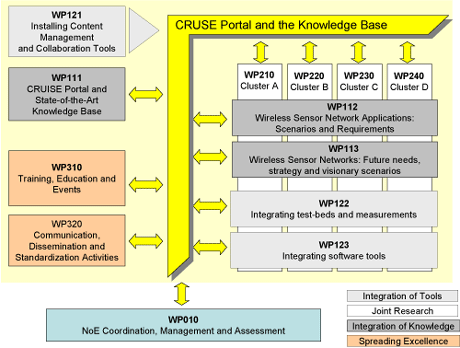by Gabriele Kotsis, Anelia Mitseva and Neeli R. Prasad
Recent developments in research and technology have drawn attention to wireless sensor networks as one of the key enabling technologies of the next ten years. ubiquitous intelligent sensing environments have a promising future in supporting the everyday life of European citizens, bringing important social benefits for each person and for society as a whole. Taking into account the current fragmentation of European research in this field, the CRUISE Network of Excellence (NoE) aims to be a focal point in the coordination of research on communication and application aspects of wireless sensor networking in Europe.
CRUISE's NoE partners are combining their efforts to make a significant contribution to both the coordination and the effectiveness of research into the communication and application aspects of WSN in Europe, promoting not only open cooperation between individuals and organisations from European academia, but also research into cooperation with industry. The main aim for CRUISE is to push for a broad integration of actions and to become one of the focal points for these actions, with the strategic goal of greatly strengthening the European position in this area of research. CRUISE is to amalgamate the majority of European research entities in the field of Wireless and Sensor Networks. It is doing this on the understanding that this critical mass will put the European Wireless and Sensor Networks research community in a position to successfully compete with the US and Asia and to provide support for European industries in this field. These high-level objectives are pursued in activities such as:
-
evaluating state-of-the-art wireless sensor networking and collating research topics covered in CRUISE and in Europe into a knowledge model
-
depicting a path from current technological status to a successful near-term and long-term vision, by creating the vision and roadmap on necessary research in wireless sensor networking in Europe
-
implementing a set of well-defined joint research activities and publishing white papers and a joint book providing an integrated research view
-
sharing and integrating methods, software tools and test-beds and making an inventory of the existing platforms and evaluating of the experiences using them
-
facilitating the mobility of researchers and PhD students as a key factor for integration and rationalisation of research efforts
-
creating distributed PhD teaching curricula and training curricula in sensor networking and related topics; Organising regular CRUISE Schools as a tool for training young researchers and communicating with the industry standardisation community and international research community
-
organising open collaboration events with industry, SMEs, academia, other projects with participation of experts from Europe, the USA and Asia, ie, cluster meetings, workshops, roundtable discussions, web-based tutorials, discussion forums, etc., to exchange and discuss ideas and to further elaborate thoughts exploiting CRUISE results.
The joint programme of research activities (see figure), is structured in four self-contained but still inter-related clusters: Cluster A - Architecture and Topology; Cluster B - Protocols and data fusion; Cluster C - Security and Mobility; Cluster D - Transmission.

CRUISE Services to Industries, SMEs and the Public
One of the main goals of CRUISE is to establish efficient and durable links with industry, using existing relationships and collaboration frameworks as a lever. Each CRUISE partner is to further develop existing liaisons with industry. In order to provide mechanisms of knowledge transfer, the project consortium is to offer 'Business Deck'@CRUISE via the project website. Members of 'Business Deck' are offered access to some of the internal documents prepared by the network. They could influence the choice of topics for tutorials prepared by the network and, to some extent, over topics presented at training schools organised by the partners. They could be also involved in the tools' integration activities.
Cooperation with industry is also to be carried out through links with other IST R&D projects working on close topics, such as eSENSE IP, MAGNET BEYOND IP, GoodFood IP, and through national projects. Special attention will be paid to promoting collaboration with SMEs, which are expected to play a particularly important role in the deployment of sensor networks, but which often lack specific research recourses in order to complement their own skills. Via the CRUISE Portal, SMEs will be able to reach a working group or an appropriate expert from the project with a specific problem to be solved. Adding to the above, CRUISE is to create links with other related IST projects, such as NoE, e-NEXT, NoE NEWCOM, NoE ACE, Coordinated action Embedded WiSeNets.
Last but not least, as part of the plan for using and disseminating the knowledge and to raise public awareness about the immense social benefits of the sensor network applications, active collaboration will be pursued with professional communities and organisations whose interests span different aspects and scenarios of sensing environments apart from the purely technical ones. This will serve the European community beyond academia and science.
This work has been carried out within the framework of the IST-4-027738 NoE CRUISE, which is partly funded by the European Union. The project started on January 1 2006 and has a duration of 24 months. Thirty two internationally recognised groups from Europe, including the ERCIM members VTT and Fraunhofer-FOKUS, are coordinated by the Center for Telenfrastruktur (CTIF) at Aalborg University, Denmark.
Link:
http://www.ist-cruise.eu
Please contact:
Neeli R. Prasad, Aalborg University, Denmark
E-mail: np![]() kom.aau.dk
kom.aau.dk










